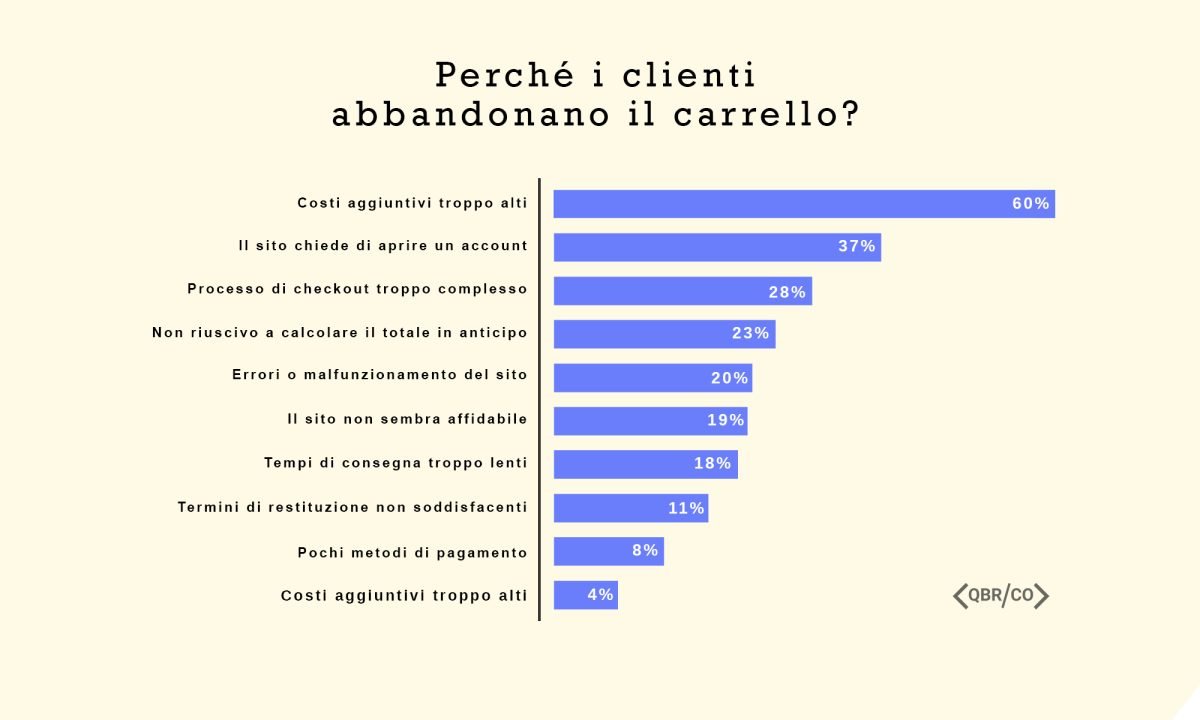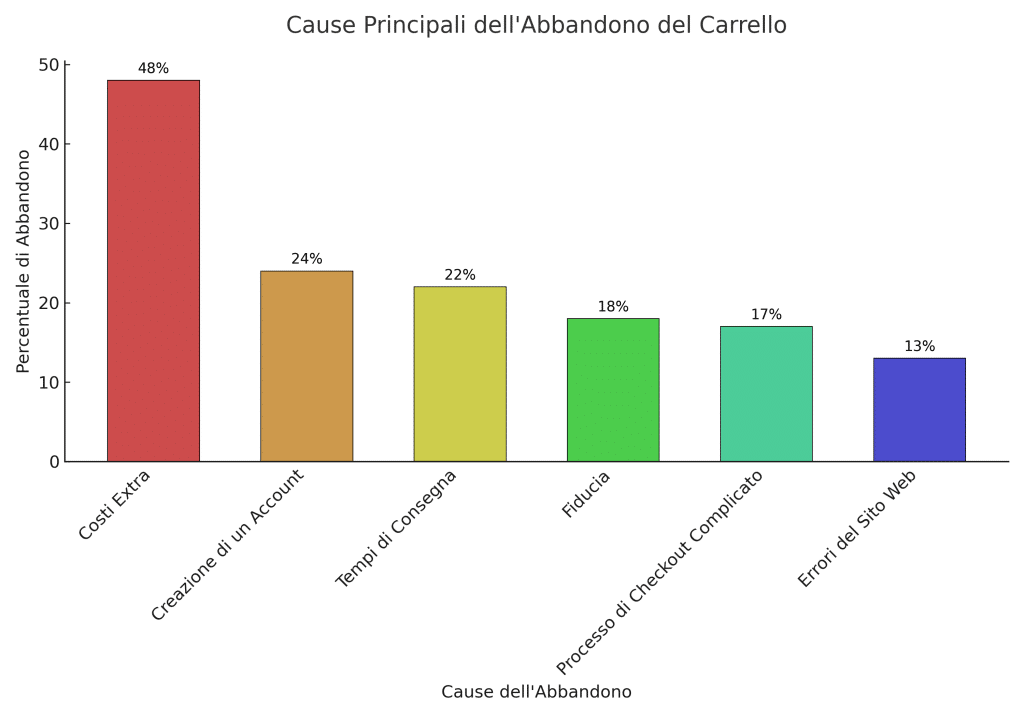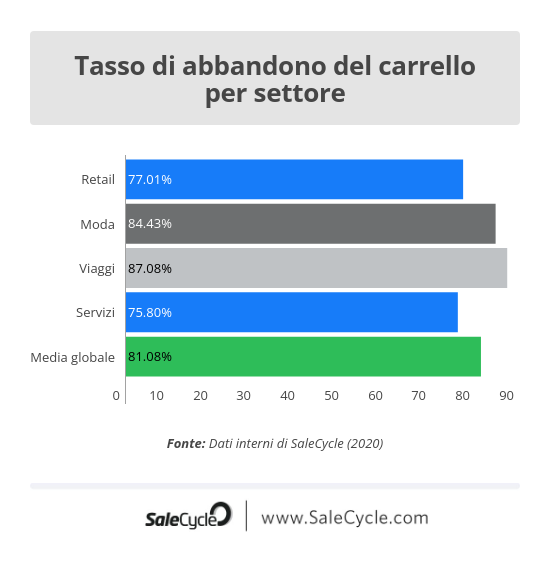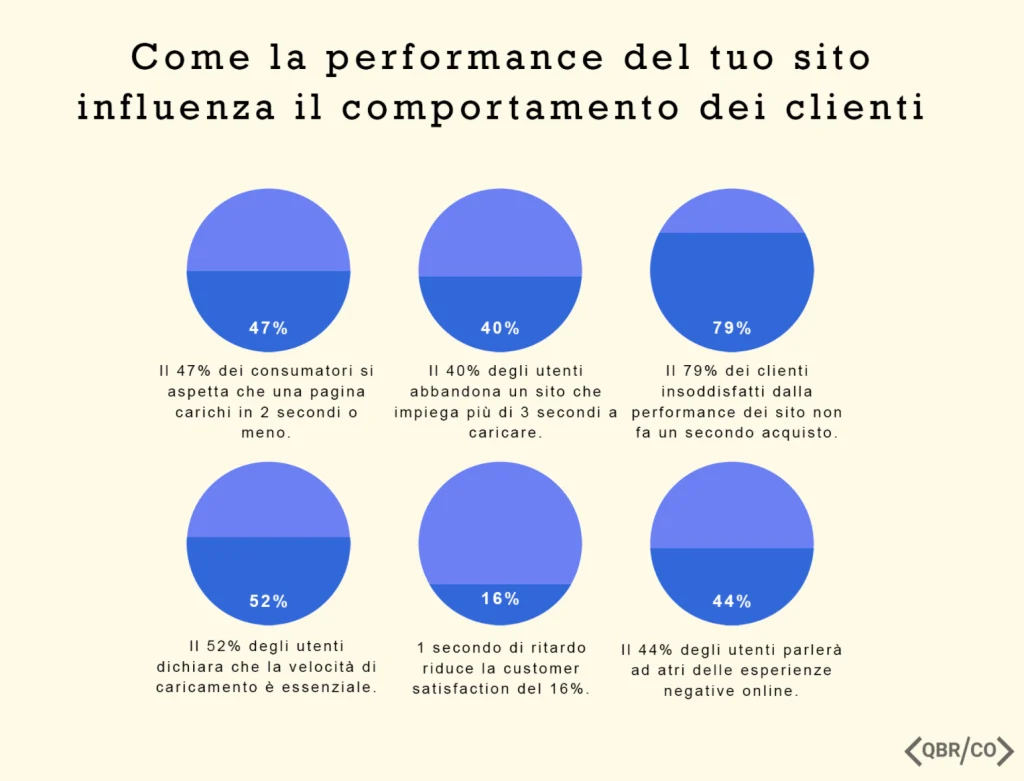Table of Contents
Welcome, digital explorers, to the pulsating heart of online success!
In this article, we will embark on an exciting journey through the intricate paths of the e-commerce world, with a sharp focus on a common but surmountable obstacle: the abandoned cart.
Imagine your online store as a high-speed race on the digital commerce superhighway. You’ve attracted enthusiastic visitors, captivated them with irresistible products, but suddenly, something slows the pace: cart abandonment. It’s like an untimely detour on the road to success, but today we are here to chart a course that will smoothly guide you to the finish line of maximum performance.
Are you ready to overcome this obstacle with targeted strategies and decisive actions? Well, get ready because we are about to explore together the bright paths that will lead your customers from engagement to conversion.
Why do customers abandon their carts?

Source: Qbrico
What lies behind the trend of leaving products in the cart without completing the purchase? Let’s find out together, unveiling the behind-the-scenes secrets of online shopping.
- Complex Payment Processes: Imagine a customer at the peak of excitement for conversion, only to be hindered by a tangled maze of payment. The complication of the procedure, with convoluted steps and a slow website, can drive the user away.
- Mandatory Account Creation: Many would prefer a seamless shopping experience without the burden of registrations.
- High Prices: A potential buyer, just like in physical stores, can easily walk away if the prices are too high, becoming a cause of abandonment.
- Ambiguous Shipping Costs: Just like high product costs, proceeding with an online purchase can become challenging when shipping costs are unclear.
- Checkout Complexity: This element can act as a barrier, pushing users to seek easier escape routes.
- Limited Payment Options: A limited variety of payment options can make the buyer’s journey less appealing, prompting them to look for alternatives.
In conclusion, as always, trust remains the cornerstone of this digital theater.
Below is a statistic compiled by SaleCycle that gathers the main reasons for cart abandonment confirmed by surveyed users:
- 34% were ‘just browsing’ and not yet ready to buy.
- 23% encountered issues in the shipping process.
- 18% wanted to compare various prices and offers before finalizing the purchase.
- 15% preferred to make the purchase directly in-store.
- 6% abandoned the site on the checkout page due to limited payment options.
- 4% encountered technical issues.

In the travel and tourism sector, abandonment causes are not only linked to lengthy research processes but also to excessively high prices.
Recent Statistics on Cart Abandonment Rates
Compared to the study conducted by SaleCycle, which reported an 81% cart abandonment rate in 2020, the Baymard Institute (2023 data), following research based on approximately 49 different studies, highlighted a cart abandonment average close to 70% for 2023.

Despite a slight decrease, it remains evident that the majority of users do not complete their purchases.
This decrease could be attributed to the Covid-19 pandemic, which led to a significant increase in online shopping, resulting in a subsequent reduction in abandonment rates.
6 Techniques to Reduce Cart Abandonment Rates
While the shadow of cart abandonment may cast a veil of concern over e-commerce managers, there is a positive note: numerous strategies and solutions are available to brands to minimize cart abandonment rates and encourage users to complete their purchases.
Below, we present several tactics that e-commerce platforms can consider to address and resolve the longstanding issue of cart abandonment. We are ready to explore together the illuminated paths that will lead to increased conversions and lasting success!
1. Ensure Smooth and Fast Navigation
Another element contributing to mitigating cart abandonment is the optimization of the navigation interface. Users demand a shopping experience that is not only simple but also fast and engaging, with the site easily adapting to both desktop and mobile devices.
Revealing data and statistics from Qbrico, it emerges that 40% of users decide to leave a site if the pages take more than 3 seconds to load. This underscores the crucial importance of offering smooth and fast navigation to keep users engaged and satisfied during their online shopping journey.

Source: Qbrico
The search for products and/or services is a journey that requires patience and reflection. Before reaching a final decision, users explore and compare prices and sites, searching for the most advantageous offer. The key to transforming an increasing number of visitors into customers lies in providing relevant and timely content and information, positioning your site at the forefront of users’ minds.
For example, travel sites can enhance the user experience with tourist guides, facilitating the choice of a destination. Similarly, fashion or retail sites can enrich their offering by including authentic customer reviews. This strategy not only accelerates the decision and purchasing process but also amplifies social proof, giving users the confidence needed to make the right choice.
2. Simplify Shipping and Return Processes
The effectiveness and promptness of shipping and return procedures, along with payment alternatives, are key elements for users, facilitating a smoother and more seamless purchasing process.
These aspects are of crucial importance for user satisfaction, requiring retailers to constantly strive to exceed competitive expectations.
With regard to shipping and delivery, consumers seek the ideal balance between speed, convenience, and prices. Some might be willing to wait a bit longer if it results in free or significantly cheaper delivery.
Facilitating quick and easy return processes contributes to customer happiness and satisfaction, giving them the confidence to make changes or returns without complications.
However, facing return requests from customers is inevitable. Therefore, adopting easy and fast return processes emerges as a crucial aspect that e-commerce sites must consider to meet customer needs and encourage additional purchases.
3. Streamline the Checkout Process
The payment moment is crucial during your online shopping journey. For this reason, it is essential to make it easy and intuitive, both from a computer and a smartphone.
To simplify everything, it might be helpful to eliminate the obligation to register and add the ‘guest checkout’ option to give customers the freedom to choose. Next, when the order is ready, consider offering them the option to create an account, perhaps offering some gifts or a percentage of discounts in return.
There are also useful little tricks you could adopt:
- Use a ‘progress bar’ to visually show the missing steps in the payment process.
- Keep everything on a single page.
- Store payment and shipping details to allow users to complete the purchase with a single click.
4. Implement Remarketing Activities & Send Summary Emails
When a customer abandons the cart, it is not necessarily a sign that they have lost interest. Most likely, they are just looking for that little push to speed up their purchase decision. In this context, an effective strategy to reduce abandonment rates is to test and discover the ideal times to send remarketing emails and SMS, encouraging the recovery of abandoned carts.
Several tests have shown that sending remarketing emails and SMS within the first two hours of abandonment proves to be the winning move.
Furthermore, if visitors are not yet ready to complete a purchase or need additional details and assistance, there are several potential solutions to stimulate the conversion rate and increase online sales. One of these is sending summary emails of products left in the cart.
You might find it helpful, regarding email marketing, to delve into the topic by reading our article on email marketing automation.
5. Customer Reviews
Useful for instilling trust in potential buyers, it is advisable to encourage loyal customers to leave reviews testifying to their online store shopping experience.
Today, one of the most common behaviors of those who want to make an online purchase is to read reviews not only of the product but also of the website and the company.
6. Secure Payments
Finally, but not least in importance, it is essential to offer online payment security to reassure customers about the protection of their personal data.
CONCLUSION
In conclusion, we have examined the phenomenon of cart abandonment to try to understand the motivations behind this behavior and have presented several dynamic solutions to address this issue.
The goal of this article was to focus on the importance of improving the user experience while navigating within an e-commerce site, making their interaction with the site not only enjoyable but also profitable.
